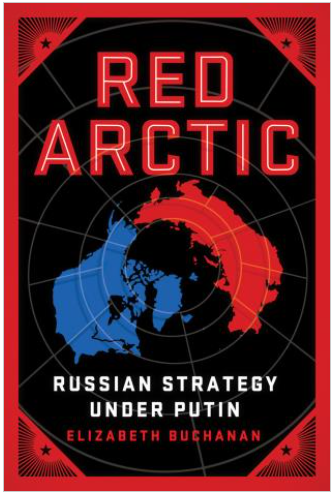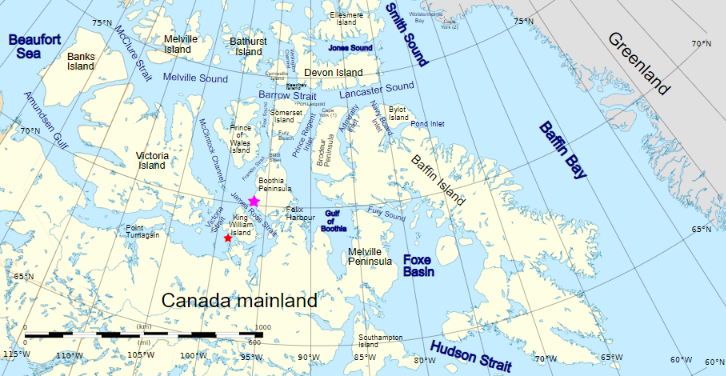Elizabeth Buchanan notes that publishing a book just as the central character invades a neighbouring country presents an array of challenges. There are also difficulties in reviewing said book, when – understandably enough – new arguments appear in the afterword.

One argument, however, is consistent throughout Red Arctic: Russian Strategy Under Putin, being that Russia offers cooperation in the Arctic and that the West has and must continue to respond in kind. It is an argument vigorously directed against the Cold War view that Russian aggression will surely bring military conflict to the Arctic. It is always favourable to offer a calming corrective to any over-blown and over-simplified rhetoric about Russia, other examples of which include Russia’s economy being a basket case; its education, health, and social welfare sectors being neglected disaster areas; and any Russian of wealth being Vladimir Putin’s close friend and private banker.
However, there are dangers to taking on Cold War “stereotypes,” even while Buchanan refrains from employing the loaded word directly. One is that the stereotype is not in fact widely held. There are certainly those that talk of the Arctic as a future zone of conflict, but there are many – including among those with no love for Putin – who do not, and judging by Buchanan’s own evidence, Western policymakers are among them.
Another danger is that stereotypes very often have a kernel of truth to them. Buchanan tackles this directly, noting Russia’s partial remilitarisation of the Arctic, the expansion of its territorial claims, its narrowing position on access to the Northern Sea Route (NSR), and at times aggressive rhetoric and showy propaganda actions, most notoriously the flag planted on the seabed under the North Pole, in her analysis. However, she does not see this as so concerning as to justify the withdrawal of cooperation by the West. That could well be a valid calculation, although surely such things cannot be so blithely dismissed as “first and foremost, propaganda tools directed at Russia’s domestic audience.”
The final danger of taking on stereotypes is that, in doing so, one is blinded to the broader picture. Once again, this is not something of which Buchanan can be accused. She directly faces the issue of the implications for relations with Russia in the Arctic of Russia’s behaviour elsewhere, and answers very clearly that the Arctic should be “siloed.” It is here, unsurprisingly, that the argument changes from the main text to the afterword. Before the invasion of Ukraine, Buchanan describes a willingness of the Western nations to cooperate with Russia in the Arctic, including by investing in Russia’s offshore Arctic energy projects, and is confident that the investments will return even after post-Crimea sanctions. Post-Ukraine, she is not so sure. The tone of her argument becomes more urgent, as does the reason that cooperation is so important, with climate change becoming far more prominent in the afterword than in the rest of the book. This reason, of course, is that cooperation is essential to save the Arctic. The problem here is that her view that Russia’s primary interest in the Arctic is its hydrocarbon reserves – the exploitation of which requires cooperation and stability, not war – remains unchanged. Forgetting about geostrategic tensions and Russia’s ambiguous at best attitude towards climate change, why should the West cooperate with Russia to develop its hydrocarbon reserves to save the Arctic from climate change?
It could well be that dialogue is the best way of resolving the contradiction between climate change and Russia’s energy ambitions. But it is insufficiently promising for me to be convinced that the Arctic deserves to be “siloed” at this point in time. That is not to suggest that I think that the Arctic should or is likely to become the next zone of armed conflict.
If not a zone of armed conflict, will it be commercially important? As already stated, Buchanan sees Russia’s Arctic strategy as being driven above all by the desire to access huge hydrocarbon reserves and thereby assure Russia’s economic future. She recognises that the deep waters outside Russia’s exclusive economic zone are unlikely to be exploitable in any foreseeable future, and that even the commercial prospects of the offshore shelf is debatable, leaving onshore or near-shore exploitation as representing the future. Certainly, developments in those areas appear to have commercial viability, although as is so often the case the contribution made by government subsidies is hard to measure. Buchanan warns, particularly in the afterword, that if the West continues to refuse to work with Russia in the exploitation of those assets, other countries – above all China – will step in. In her view, China is also very interested in developing the NSR. She is aware of the nervousness in Russia about becoming too dependent on China, and uses the “China factor” as an argument in favour of Russian-Western cooperation in the Arctic. This is of course an argument applied more broadly to Russian-Western relations. One can understand the logic, although in this case one suspects that Buchanan overestimates both the chances of Russia changing sides and the degree of Chinese interest in the Russian Arctic, including the NSR. It is also far from clear that the Chinese can replace the technology required to enable Arctic projects to proceed, even if it were vitally interested.
These are complex matters of technological capacity and commercial calculation on which no one can claim certainty at this time. Buchanan provides a good framework for an ongoing watching brief. The broader issues of cooperation – particularly “siloing” – are serious ones well worth debating, and not just as related to the Arctic. Buchanan gives us a good opportunity to further that debate.
This is a review of Elizabeth Buchanan, Red Arctic: Russian Strategy Under Putin (Rowman & Littlefield/Brookings Institution Press, 2023). ISBN: 978-0-8157-4004-9
Stephen Fortescue is Honorary Associate Professor in the School of Social Sciences, UNSW Sydney, and Visiting Fellow, Centre for European Studies, ANU.



